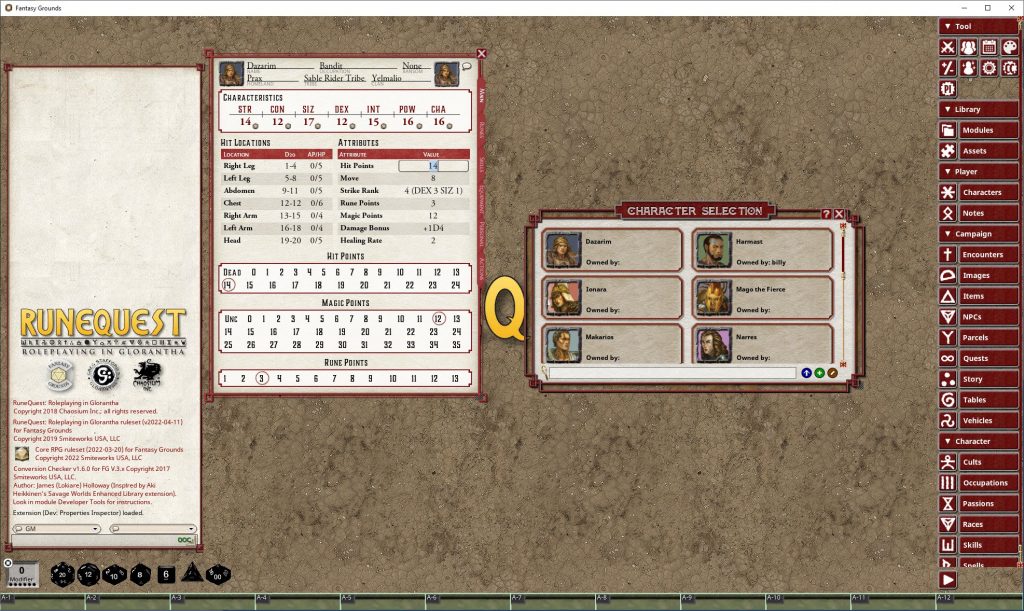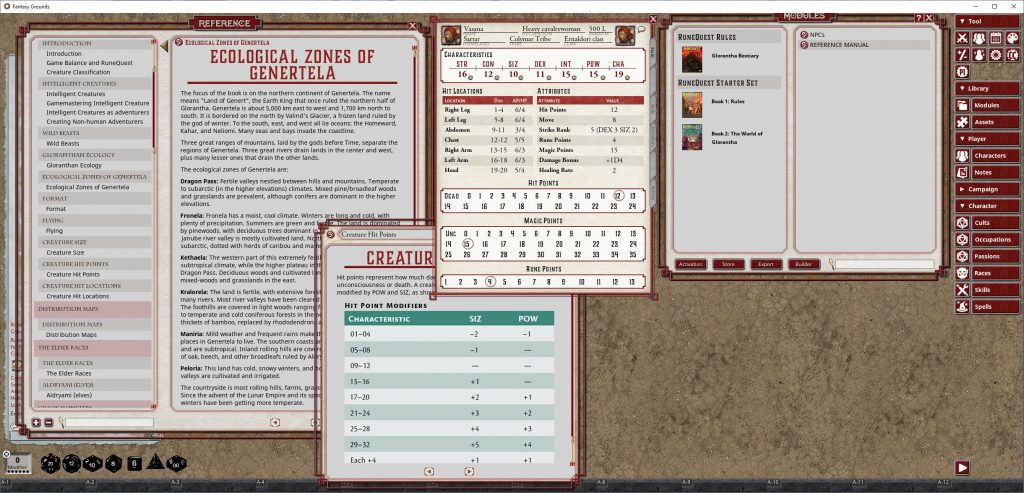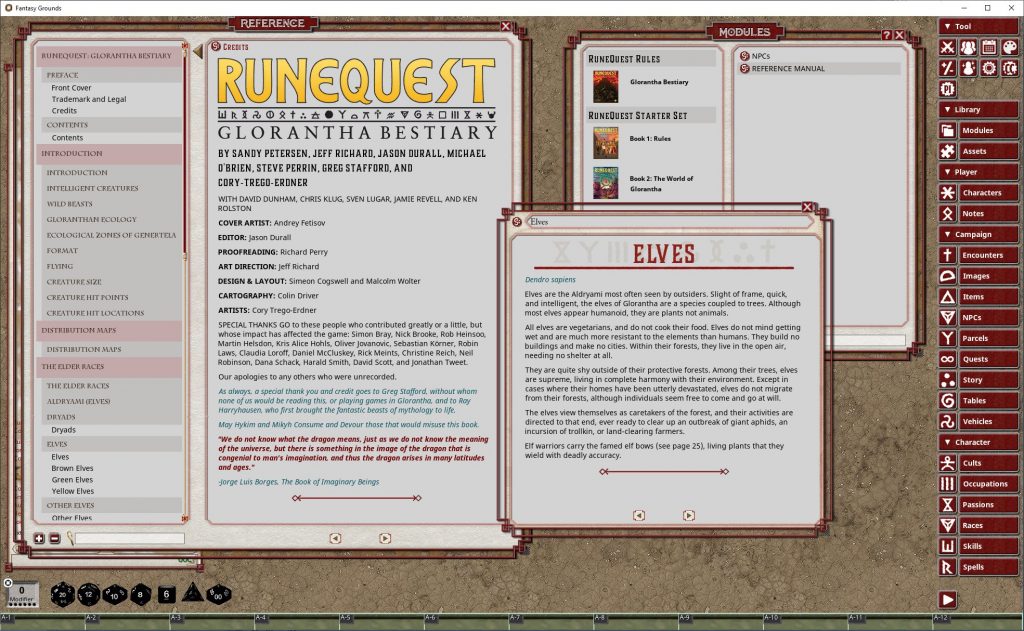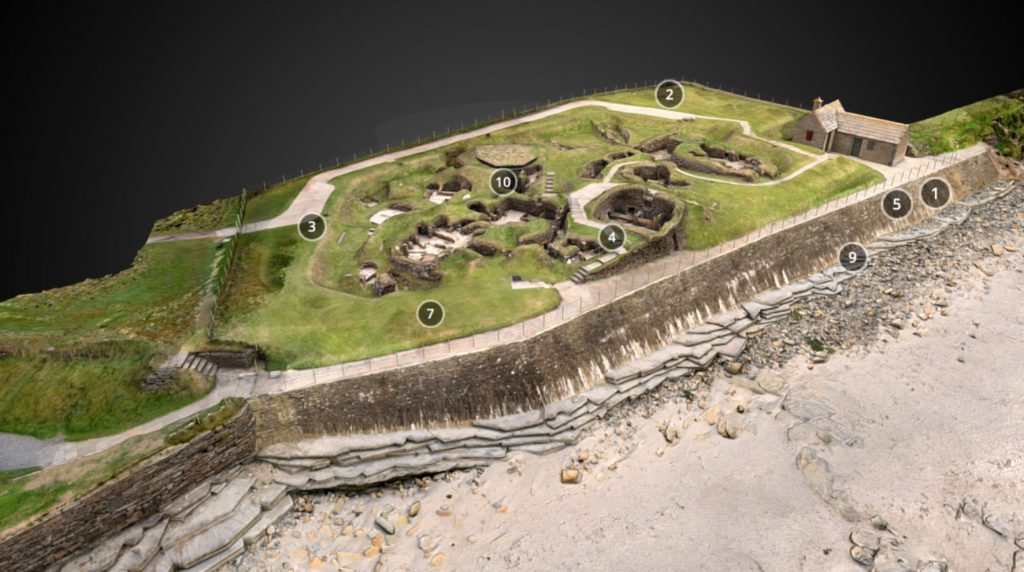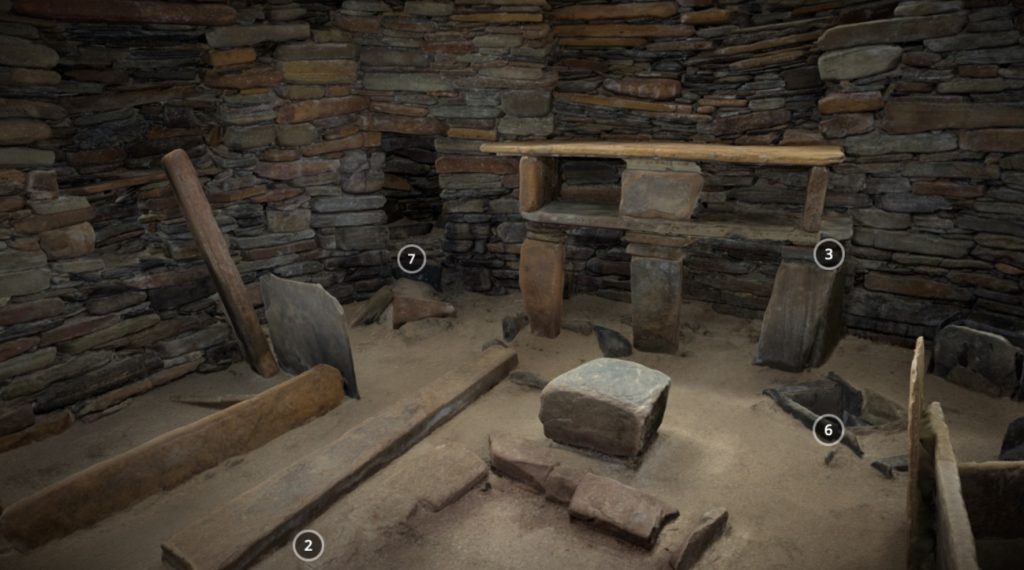Welcome to a new issue of the Journal of Runic Studies, the premier Malkioni publication for studies into the nature of Glorantha. If you haven’t subscribed yet, please consult with the spirit bound to the appropriate electronic page.
Lots of posts from Jeff this week while I was busy with work… hence the slightly late Journal issue with less in-depth annotation. Oh well!
God Learner Sorcery
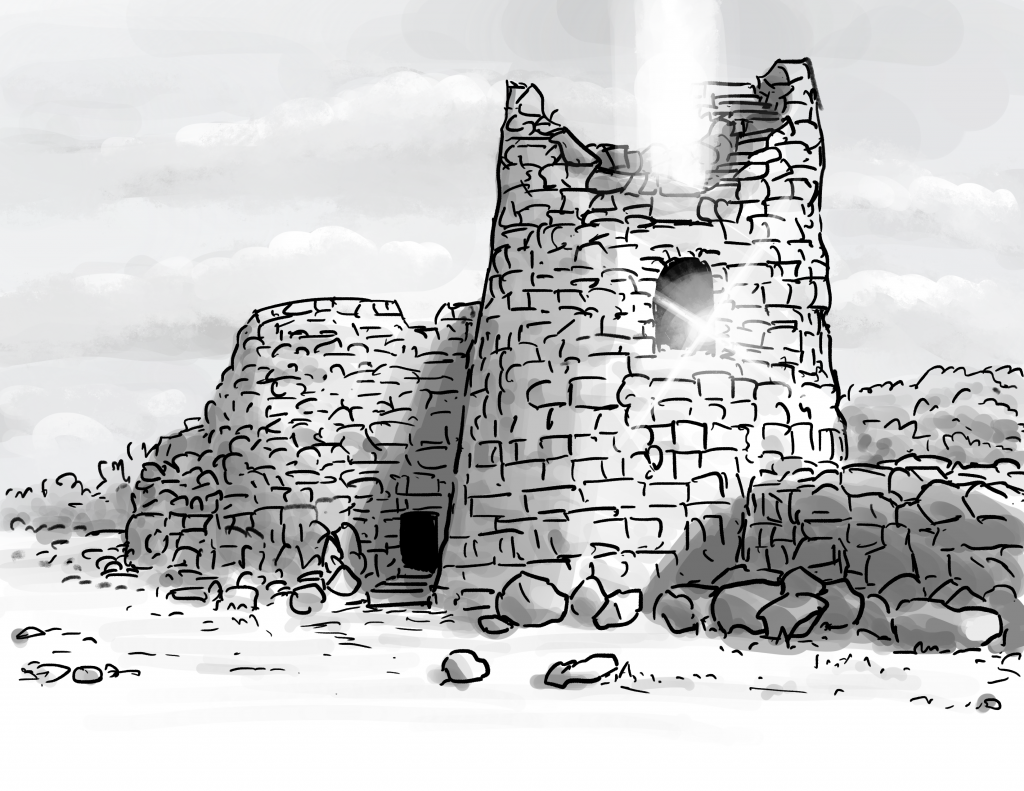
Here is what us God Learners were up to this week.
Initiation Series Episode 6

Episode 6 of the Glorantha Initiation Series is out! Wayne played RuneQuest once in the 80s and hated it. More than 30 years later he returns to Glorantha and talks about riding Praxian mounts, making miniatures, YGMV, ducks, silly location names, and more!
ChaosiumCon 2022 Report

I was at ChaosiumCon 2022 and wrote about it! Some pictures, some anecdotes, and a lot of praise for a great convention that I hope will become a regular thing!
Chaosium News

Here are this week’s Chaosium news!
Read These to Improve Your RuneQuest Games
Jeff shared the books that are useful to better grasp Glorantha. You’ll hear the usual suspects: Jung, Campbell, Eliade, Wolfe, old myths like Innana’s Descent into the Underworld, and so on. Plus, a lot of context around Alexander the Great.
When Players Know More Than You
James interviews Jason Durall about how to teach a setting to players who don’t know anything about it… and how to deal with players who turn out to know a lot more than the gamemaster.
I ran a short Star Wars campaign for a group that involved a giant mega fan, and it was actually quite liberating because I could just rely on him to tell us how this or that works. Most of the time it added to the story, rather than derail it.
Updates on RuneQuest Fantasy Grounds
Development continues on the RuneQuest support in Fantasy Grounds, according to the main coder. The general theme seems finished, and the character sheets have the Starter Set treatment:
The Bestiary material is also getting there:
I haven’t seen any updates for Roll20 or The Forge, which are supposed to also be coming.
Jonstown Compendium

The Jonstown Compendium is Chaosium’s community content program for all Gloranthan games, hosted on DriveThruRPG. Disclaimer: all the relevant links are affiliate links that hopefully will let us cover some of the hosting and maintenance costs for the website and podcast! Thanks for using them!
Settlement Map 15

The Jonstown Compendium has been pretty quiet lately, so the only release is a new settlement map from Mikael Mansen.
Sneak Peek at Legion Games’ Next Item
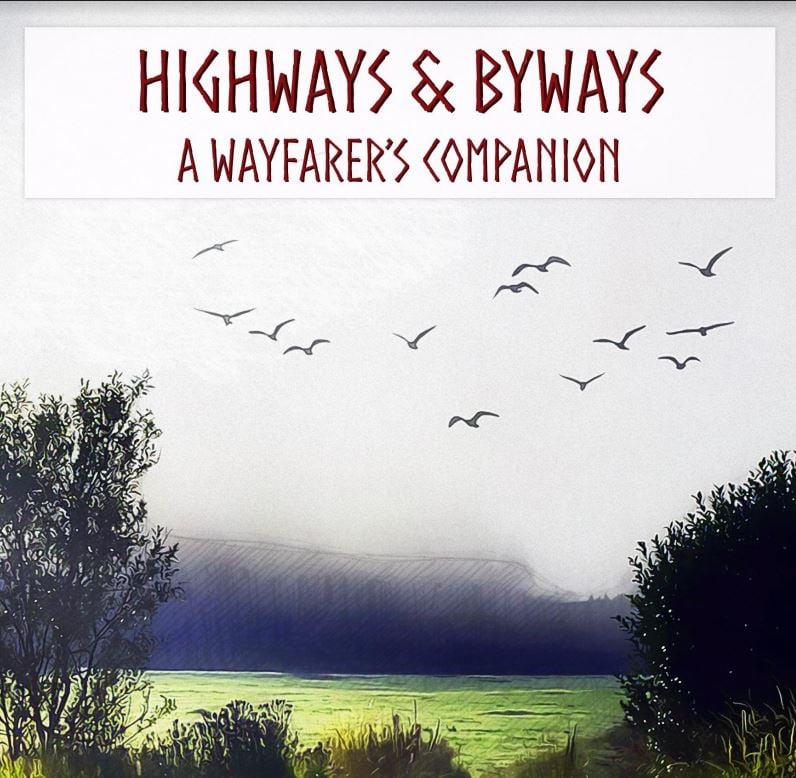
This is supposedly coming “later this month”, from Neil Gibson and friends, who previously did things like LEGION. And in the meantime, Rubble Redux: Insula of the Waning Moon is discounted to $7.
Jeff’s Notes

Jeff Richard, the current mastermind on everything Gloranthan at Chaosium, is often posting notes and thoughts on the RuneQuest Facebook group. Here’s our curated list from the past week. A partial archive of these sources is compiled on the Well of Daliath.
Heroquesting Lexicon
I was lucky enough to get a taste of the upcoming heroquesting rules at ChaosiumCon, so I know a tiny little bit to annotate this glossary!
Note that the following terms are those used in the heroquesting rules. They’re possibly the terms used by the God Learners too, but the majority of people in Glorantha wouldn’t be very strict about how they talk about visiting the God Plane, and most likely wouldn’t use those terms.
CHALLENGE
The Challenge is a formal contest in which participants pit their very selves, or parts of themselves, in a magical battle against a similarly anted foe. Challenges are deliberate and can only be accidentally triggered by a heroquester’s chosen opponents, in which case they will have some warning beforehand. Many cults and religions have specific challenges that their worshippers can undertake with a good chance of success if the preparations and teachings are followed.
We did go through a couple formal challenges in the game. It’s dangerous because failing a challenge makes your character lose bits of themselves (I think you lose points in characteristics, Runes, and/or Passions). But if you succeed a challenge you get a boon, which is sometimes a spell or ability found in one of the rulebooks, and other times is a rules-breaking power that’s unique and awesome.
GOD TIME
In the God Time, there was no division between the worlds of men and gods, between Life and Death, or body and spirit. The events and deeds of the God Time made the cosmos and established its patterns.The Gods War introduced the power of Death, which separated all with violence, death, and entropy. Reality was fractured. The eternal gods would have ceased to exist but for the Cosmic Compromise, whereby the gods voluntarily abdicated their free will within the temporal world rather than lose all into the maws of nonexistence. The gods remained eternal at the cost of being limited to their God Time patterns.
We met some deities and mythical figures during our heroquest, such as the Rainbow Goddess, various Moon Goddesses, Humakt, and so on. In most cases they were indeed just stuck doing what you expect them to be doing given their backstory. There were also many unnamed or unidentified entities. We didn’t know who or what they were and frankly we didn’t really wanted to get too close and find out.
Characters can acquire heroquesting “techniques”, which let them affect the mythical landscape and denizens of the God Time. Some techniques which I really like (but didn’t get to use) involve being able to point at one of those unnamed or unidentified entities and, well, name or identify them. Do you need a flying horse or a giant boring insect to get from location A to location B? Sure! Roll under your Mastery Rune (it starts at around 20%), use some augment and spend some Hero Point(s) to increase your chances, and lo and behold there’s a flying horse or giant boring insect. You might have to convince them to help you out, and you might have to further roll to see if you don’t fall off the horse or get crushed by the insect, but hey, such is the dangerous life of a heroquester.
GODS WORLD
The realm of eternity. Every god and goddess who performed great immortal deeds is found here. Within this world of extremes lie the heavens and hells of the cults, where initiates and devotees go after death. Here, too, lie the great pools of creative material from which were made the primal oceans, ancient mountains, and first skies of the mundane world.Often synonymous with the God Time.
I don’t really grasp the difference. Maybe the God Time is the reality of pre-Time cosmos, while the Gods World is the place? So the Gods World exists within the God Time?
HERO
A hero is any mortal that exists simultaneously in both the Mundane and the eternal Gods World.
I think that means someone with a Hero Soul, i.e. someone who heroquested enough that other people can worship them and their accomplishments in the God Time. This was mechanically vaguely described at the end of The Smoking Ruin, but there’s a good chance this mechanic will have been tweaked and changed by the time the full heroquesting rules are published.
HERO PLANE
This plane exists simultaneously in the temporal Mundane World and the eternal Gods World (and sometimes the Underworld). There live legendary beings, including worshiped heroes or traditional enemies. Incarnations of the gods manifest easily here and interact with beings and things. Mundane beings can interact with the Gods World while on the Hero Plane, enabling them to experience the God Time and bring its power to the Mundane World.
In my head canon the Hero Plane is what you call the intersection between the Mundane World and the God Time. It’s what people experience when they participate in a heroquest ceremony without being the “main” heroquesters. In that case these “extras” (dancers and singers and such) witness and interact with gods and weird entities manifesting during the ritual, while the important people depart for the God Time proper. So I picture the Hero Plane as the sort of bubble of weirdness that forms around the “portal” that heroquesters open.
But from what Jeff writes it sounds like it’s more than that? Maybe it’s a mythical plane for famous people who haven’t ascended to godhood and therefore don’t exist in the God Time? So for instance Argrath does some heroquesting to bring the White Bull back and such, and you would only experience that in the Hero Plane, not the God Time? I don’t know if the difference will be mostly academic, or if it will have some mechanical aspect. Greg’s notes in Arcane Lore described a cost difference between going to the Spirit World (Discorporate spell, costing one Rune Point), the Hero Plane (two Rune Points) and the God Time (three Rune Points). Maybe the Hero Plane is also safer because you interact with proxies and avatars and incarnations of deities, instead of the deities themselves when in the God Time? Oh well… so many questions.
HERO SOUL
The Hero Soul is that part of a mortal being that has immortality in the God Time. The Hero Soul must be awakened through heroquesting. Once awakened, the hero exists in two worlds, the Mundane World and the God World. The Hero Soul can lend its power to its mortal self, but requires worship to replenish itself.
See, this is confusing — how is the Hero Soul not in the Hero Plane? Anyway, I believe that’s the mechanic teased in The Smoking Ruin. As far as I know, it’s basically a dedicated pool of Rune Points that power the boons you obtained while heroquesting, only you don’t replenish those points by worshipping gods, you replenish those points by having other people worship you. I hope that mechanic stays because I really like it!
MAGIC ROAD
Glorantha is crossed by many magic “roads” that enable a quester to quickly travel to specific holy places along paths that skip in and out of the mundane planes, covering the distance in far less time than travel wholly on the mundane plane. Deities and spirits, or their avatars, are presented here, summoned by the magic of traveling on the road; ritual enemies are often summoned by the same magic.
When we played our game with Jeff, we were sometimes travelling along “paths” found on the God Time map we had (see below). Once we might have taken a shortcut, I’m not quite sure.
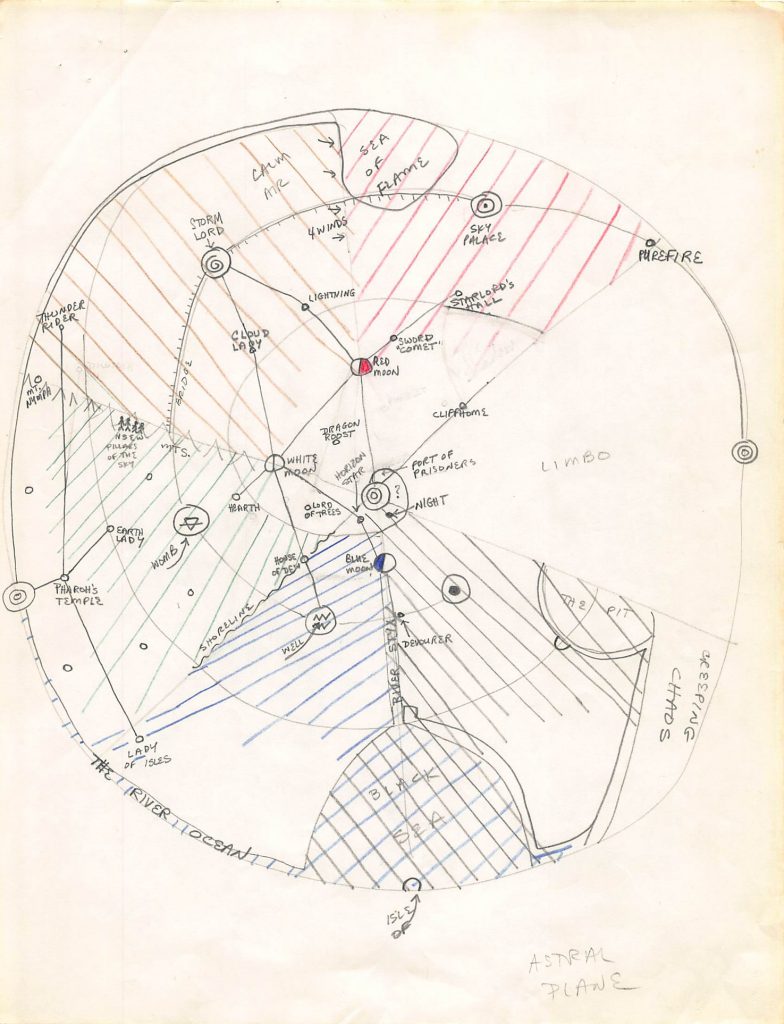
We crossed over from the destroyed Orlanth temple at Whitewall and ended where the “Storm Lord” is on the map. Then we went on the “Bridge” and encountered the Rainbow Goddess. We asked her to build us a rainbow bridge to the White Moon. I don’t know if that was technically the “Cloud Lady”, or if we got off the map there. I don’t even know if those connections on the map are the same as “magical roads”, anyway. Sooo… well, I guess that wasn’t very helpful.
MUNDANE WORLD
This is the world of mortal beings, bound by Time. This is the physical world, of Life and Death. This is the world of your RuneQuest adventurers.SPIRIT WORLD
This world is made up of non-physical (discorporate) entities and things. It has a correlation with the Middle World in that many spirits maintain their relative spatial positions in the Middle World and the Spirit World. It is a place of sublime beauty and life, but also where lost spirits wander, where broken dreams coalesce, and where nightmares feast.The Spirit World can be visualized as a place without gravity or an exterior light source, but which is instead filled with various shapes of color. Real perception is limited, and depends on both the power of the viewer and the viewed.
The Spirit World is made of many smaller parts that are distinct but connected to other locations through spiritual pathways.
UNDERWORLD
The Underworld is the irrational ancestress of known Glorantha. It precedes all that can be known, and thus cannot be truly known. It houses mystery, spawns mystery and is a mystery itself. Many Gloranthans think that all the worlds of Glorantha spawned from the Underworld.Hidden deep underneath the center of the bottom of the lowest Underworld is the Chaosium, the Fount of Chaos, which spews forth both monstrosities and raw unformed “stuff” into the world. What no sane Gloranthan really understands is that, without this Chaos entering the world, everything would be locked into Stasis.
Note how the Mundane World is also called the Middle World, probably because it’s located between the Underworld and the Sky World or something. Or maybe Greg was reading too much Norse Mythology. I also love how the Chaosium is a place in Glorantha.
Prax and the Wastes
Hold on to your riding beasts, we have a long series on Prax and its tribes.
Beyond Vulture’s Country is the vast lands of Genert’s Wastes. Although Vulture’s Country is an arid badlands, there are grasslands and scrublands in the Wastes. Although the Lunars were convinced that those tribes that crossed into Vulture’s Country were passing to their death, the reality is that probably two-thirds of all Praxians are in the Wastelands. But the Wastes are a harsh land – the Waha priests claim that the Praxians are tested and purified in the Wastes. Only thus are they worthy of Prax.
Almost nobody in Glorantha has a map of Genertela, so all they know about what lies beyond Vulture Country comes from rumours, hearsay, and whatever the Praxian nomads care to reveal. And when you mix in stories of the Raging Storm and such, it’s no wonder that most people think a slow death awaits anybody going there.
Jeff also shared this great map that features some of the grasslands mentioned above.
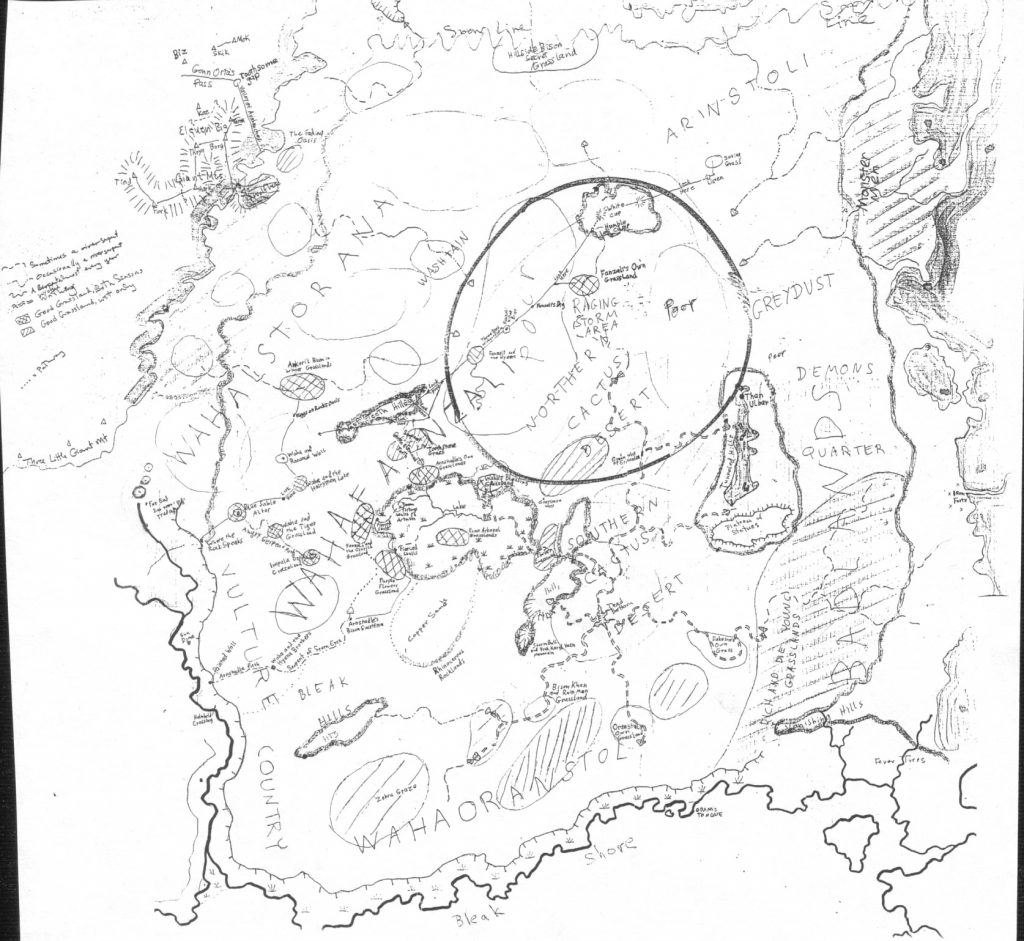
See also David Scott’s map of the Wastes’ grazing lands:
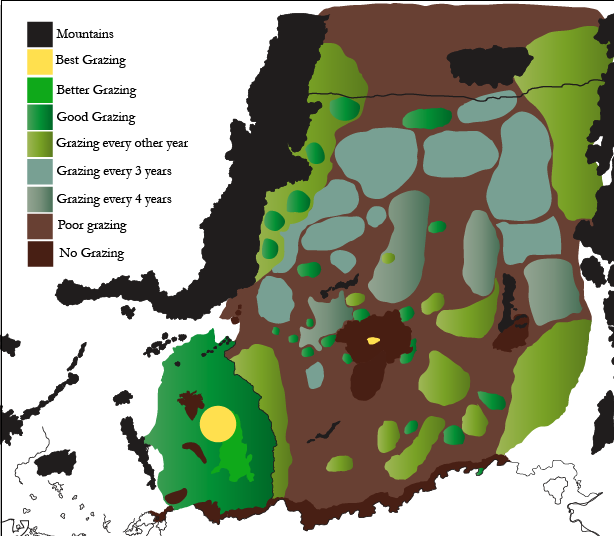
When Argrath was taken as a slave of the Bison Riders, he ended up in the areas between the Vast Teeth Hills, the Kjarlki Bog and the Raging Storm. He saw such things as the Copper Sands and the Plateau of Statues. He learned to see spirits and gods in the vast Wastes. Argrath learned to survive in the Wastes – how to find water and food, how to survive the Copper Sands and the Raging Storm. When he gained his freedom and was accepted by the Bison Tribe, he could ride and survive like a native Praxian.
Jeff expands a bit on that in a comment:
Some speculate that Argrath’s time in the Wastes served as an extended initiation and – especially when combined with his circumnavigation of the world – was key for his ability to manifest Orlanth’s power.
Back to the main note:
In the wake of the First Battle of Moonbroth, the Bison Tribe and Impala Tribe migrated en masse into the Wastelands, as did many High Llama Riders. These exiles began to return after 1621, after a decade in the Wastes.
Sor-eel, always one of the cleverest of Lunar commanders, estimated that there were no more than 100,000 Praxians in total. His successor Halcyon believed the number much lower, closer to 60,000. Imagine their shock if they ever learned there is closer to 400,000 Praxians!
It’s unclear to me what is the deal between Prax and the Wastes for the Praxian nomads. If they “migrated en masse” into the Wastelands, it means they were previously not there, or had a much smaller presence there. My understanding is that various clans were rotating between several grazing spots from Prax to the Wastes from season to season and year to year… but after the Battle Moonbroth, they all went past the Zola Fel and Vulture Country and just rotated within the Wastes for years. I’m having trouble finding much information on that though.
Notable People of the High Llama Tribe
Jeff says we should read carefully… let’s see if I can spot something.
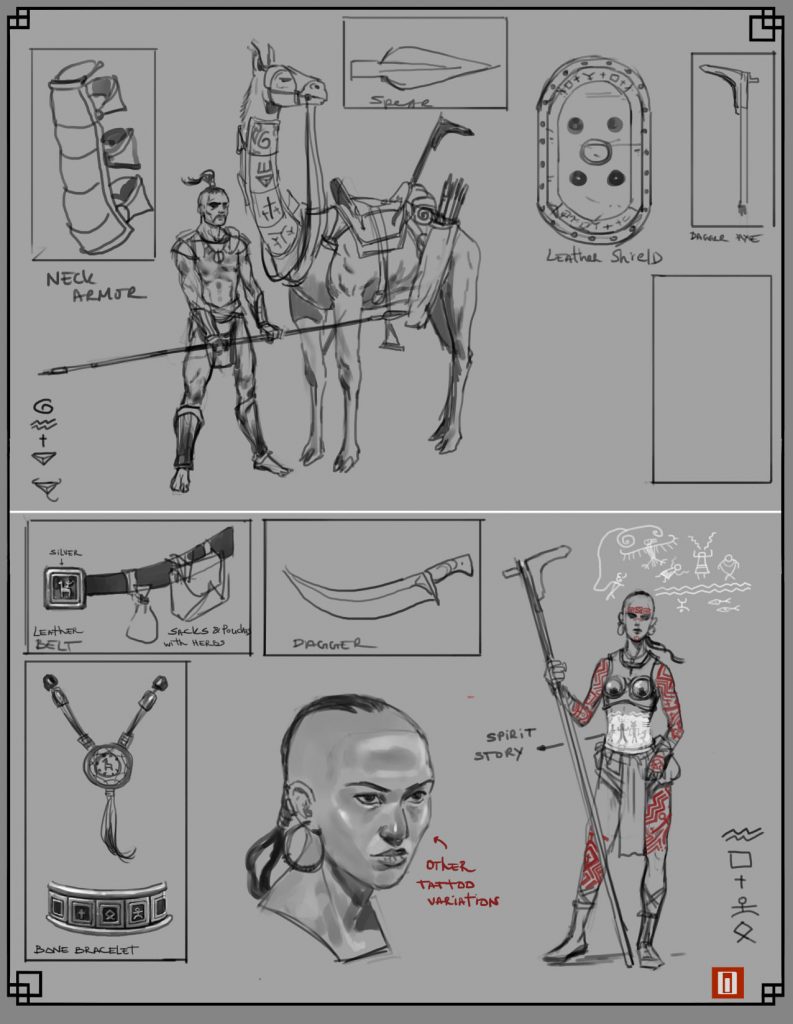
Yazurkial Blue Llama, Tribal Khan
Born 1595, Yazurkial is the high priest of Waha for the High Llama Tribe, and undisputed leader of the Blue Llama clan. He has been a close ally of Argrath’s since they were initiated together in the Dragonteeth Hills in 1615. Yazurkial is at once open-minded and gregarious, and bloodthirsty and cruel. He is Argrath’s right hand among the nomad tribes and sometimes called the Fetch of the White Bull. Yazurkial hates the Lunar Empire and has earned great renown for his defiance of the Empire. By 1625, he is already worshiped as a hero by the nomads. Yazurkial plays a role in all of Argrath’s campaigns and even though he often returns to the plains of Prax, he always returns to Argrath’s side.
Handsome and vain, Yazurkial trims and dyes his beard carefully with henna. He is very tall, strong, and very energetic in motion and speech.
Yazurkial is listed as one of the Six Allies that Argrath gathered to help him “fix the world”.
The initiation mention is intriguing. Argrath is just one year older than Yazurkial, so an initiation in 1615 would have been when they were 19 and 20 years old. It’s not a cult initiation, since I don’t think Argrath and Yazurkial share the same cult. It’s a bit late for their adulthood initiation (I think those typically happen between 13 and 16 years old), but maybe that was delayed due to them being slaves:
They were “initiated together” in the Dragonteeth Hills, while both were the slaves or captives of Narmeed Whirlvishbane.
My guess is that’s when Argrarth and Yazurkial learned some secrets from the White Bull or from dragons. After all, the Glorantha Sourcebook says that “while a slave of the Bison Tribe, [Argrath] freed the White Bull spirit and received gifts from the dragons“. We know this happens some time between 1610 and 1621, so it fits.
More intriguing is Yazurkial’s title of “Fetch of the White Bull”. Isn’t the White Bull already Argrath’s fetch? Or is “White Bull” in this case denoting Argrath himself, which… well, doesn’t help. Yazurkial is sometimes described as having “strange ideas about magic” so maybe he’s up to spirit shenanigans. His tribe supposedly rides animals that “nobody can name”. This guy’s weird and mysterious.
Vishine, Tribal Herd Mother
Born 1596 to the Blackwind Clan, Vishine is the high priestess of Eiritha for the High Llama Tribe. She is level-headed and intelligent. Vishine says that one husband is enough for her, as Yazurkial offers as much excitement as any four ordinary men, although she is not above using her considerably charm to manipulate other leaders. She shares Vazuarkial’s belief in his eventual greatness, gently nudging him from his wilder ideas. Unlike her husband she sees the defeat of the Lunars as an important end in itself.
Vishine sees Yazurkial and Argrath, with their combination of charisma and restlessness, as kindred spirits—and she is determined to steer both men towards the benefit of the High Llama tribe.
Full-figured, her face framed by luxuriant hair that appears to move with a will of its own, Vishine approaches any interaction with a knowing smile.
I think that this “Vazuarkial” is a typo for Yazurkial. Or it references someone we never heard of.
It’s interesting that while Yazurkial just hates the Lunar Empire, Vishine doesn’t see their defeat “as an important end in itself”. It’s not clear what her agenda is but I get the feeling she just wants the High Llama Tribe to become influential again in Prax. That might not involve chasing the Lunars away much farther than to the Far Place. So while her husband follows in Argrath’s war path, she might stay in Prax to take care of the power vacuum.
Orgwaha Eight-Horn, Storm Khan
This leader of the Storm Bull cult has close connections with the Kingdom of Sartar. He initially did not believe the Lunars were Chaotic but later grew to hate them with a passion. He was an early follower of Argrath’s White Bull society and by 1624 was a fanatically devoted follower of Argrath. He fought for Argrath at the Battle of Pennel Ford and summoned spirits who helped break open the Pavis Gate.
Orgwaha is impulsive, broad-faced and broad-shouldered. His face and body is heavily scarred from acid, claws, tentacles, and other chaotic appendages.
I like that he “initially did not believe the Lunars were Chaotic”. It’s important to remember that everything the gamemaster and players know about Glorantha is far from what people living there know. Whatever Praxians know about the Lunars is from the little they’ve seen during the occupation, and from all the stories and rumours they’ve heard from secondary sources, most of which might be false or baseless.
The reason he “grew to hate them with a passion” might be found in King of Sartar. At some point in the 1620s, the Sartarite Storm Bull worshippers were doing their holy day celebration despite disdain from the Lunar occupiers. Prince Temertain thought the rituals would prove fruitless after the loss of some of the cult’s rune lords in the wake of Starbrow’s Rebellion. But Orgwaha showed up that day, led by some visions or something, and officiated. Estal Donge, a Lunar spy and concubine of Temertain, had prepared some Lunar magic to disrupt those celebrations. So what was supposed to be a “simple” ritual slaying of a Chaos creature turned into an demonic outbreak. Fazzur and his soldiers slayed all these monsters at great cost, and Temertain almost got killed but was saved by Estal. Orgwaha supposedly fled back to Prax in shame and “killed himself”. I don’t imagine he actually killed himself if he’s still around in 1625, so maybe it’s metaphorical. Or it’s the author of Composite History of Dragon Pass taking the piss at Orgwaha. We know how unreliable that source is… in fact, other sources say that Orgwaha might have been behind the demonic outbreak, and that he was pretty happy when he saw the Lunars get slaughtered. So maybe he was behind it, or somehow turned Estal’s scheme against her.
Depending on what you think happened, that incident might be where Orgwaha got some of those scars mentioned at the end of his write-up. And speaking of scars, when I started reading about RuneQuest and Glorantha, I was initially confused about the existence of people with missing limbs and scars, given how healing magic is available everywhere. I only realized a bit later that:
- Each type of healing magic has a different “vibe”. So while Ernaldan and Chalana Arroyan healing magic may be “perfect”, the healing magic of Storm Bull or Babeester Gor might be far from it, leaving scars and weird-looking magical patterns on the skin.
- With the RuneQuest rules, you only have 10 minutes to re-attach a limb with magic. After that, you need to pay for Regrow Limb, and there’s probably a long waiting list for that. Some warriors might not even want to do that, and instead proudly display their wounds as proof of their valour.
- Given the 10 minute rule for limbs, one might also rule that, say, an acid burn that doesn’t get healed within that time-frame will stay forever, even if the Hit Points are recovered magically later.
Kharzdazial Blackwind, Wind Lord
A kinsman of Vishine, Kharzdazial was born in 1590. He joined the Orlanth Adventurous cult and became the leader of the Orlanth cult among the High Llamas. He pledged his loyalty to Argrath White Bull before 1621 and became part of the hidden temple of Orlanth Victorious. He is now the leader of the Orlanth cult of the High Llama Tribe and is a companion of Argrath Whitebull. His son and sister are also priests of Orlanth.
Straight up Orlanthi good boy. I like that. And I like clandestine temples.
Zamalanth, Sword of Humakt
Born 1591, Zamalanth is the half-brother of Yazurkial Blue Llama. Zamalanth dedicated himself to Humakt at the age of 16 at Tourney Altar. He is a ferocious and dedicated warrior, feared for his sword-stick that has been blessed by the God of War. He is the leader of the Swordbrothers, a feared cavalry unit that swears personal loyalty to Argrath above all things, even above clan, tribe, and death itself.
Lots of important people being super loyal to Argrath, eh? Including some of the pre-gens in RuneQuest… anyway, note to self: don’t forget to give cool names to units and bands of NPCs. The Swordbrothers, the Silver Shields, the Marble Phalanx, and so on… there’s a lot of them, and they add a lot of flavour.
Lower Farangli, Waha Khan
This warrior from the Blue Llama clan is a famed warrior. He is married to Thikidisti the Priestess.
Thikidisti the Limper, Herd Priestess
Born in 1590, Thikidisti is the assistant of Vishine. At the First Battle of Moonbroth she took an injury that could not properly heal and so she is known as Thikidisti Limper.
Orgdaka Blue Llama, Shaman
Born 1570, Orgdaka quests the Spirit World to return the Lucky Star to the heavens. He has made many pacts with powerful spirits. Rainbow Girl, the great messenger between gods and men, is a particular ally, and Lightning Boy owes Orgdaka three favors. Raven holds an old grudge against Orgdaka and pursues him from time to time. Orgdaka’s most valuable treasure is a small pouch filled with Copper Sand from the Wastes. Blown upon a foe, the sand is poisonous to all, and extremely lethal to those tainted with Chaos. Orgdaka carries several leather bags, each with a whirlvish bound to it. He uses the whirlvishes to blow Copper Sands at Chaotic foes.
Orgdaka is covered from head to toe with blue tattoos, each representing a spirit or event or place in the spirit world. Some are geometrical designs and patterns; others are beasts, birds, reptiles, and even fish.
This pouch of Copper Sand is cool (I love a good rare or unique magical item). The Copper Sands are located in The Wastes, past Vulture Country east of Prax. Nothing lives there, not even Chaos creatures. In fact, the Copper Sands were created by Genert as a last resort sort of thing to hold back the Devil’s forces, so it’s definitely anti-Chaos.
Vian Hornsaddle, Storm Khan
Vian is a leader of the Hooked Lance Clan, and takes his role as a Chaos fighter very seriously. He considers all Lunars to be Chaotic, regardless of what his senses tell him. Vian is supernaturally strong (a result of the magical crystal of gods blood he wears around his neck). He carries the clan’s magical Hooked Lance, whose bronze spearhead has a hook that can be used to disarm foes and disable enemy mounts.
I hope he’s got that crystal well secured to a solid metal chain. I know a few players who might get the wrong idea otherwise…
Important People of the Bison Tribe
And now, same thing but with the Bison Tribe.

Akasta Ironspear, Tribal Khan
Born 1582, Akasta became a Waha Khan by 1605, and became one the paramount leaders of the Bison Tribe during the 1610 Lunar Invasion. Passionately anti-Lunar, Akasta was outlawed by the Governor of Prax in 1616 for his numerous attacks on Lunar caravans in Prax. He is said to have killed at least a dozen Seven Mothers Rune Lords in single combat. Akasta is known for his hospitality and generosity which keeps him always poor, despite the profits of a hundred raids. Akasta has had more than two-dozen wives from as many different Bison Clans, although he rarely has more than a dozen wives at a time.
Narmeed Whirlvishbane, Tribal Khan
Born 1587, Narmeed became a Waha Khan by 1609. In 1611, he took the Sartarite exile Argrath as his slave (as well as the young Yazurkial Blue Llama), and was one of the first to pledge loyalty beyond death to Argrath Whitebull in 1616, and has fought alongside Argrath on many adventures. He shows greater tolerance of outsiders and other cultures than other Bison khans, and is a dangerous combination of fanatic loyalty to the White Bull with a patient, pragmatic self-restraint. Narmeed serves as one of the two leaders of the Bullocks cavalry, and fought for Argrath at Pennel Ford, Second Moonbroth, Pavis, and Hender’s Ruins. He has four wives, “one for each direction.”
Narmeed is tall and gaunt, able to intimidate with silence.
Remember my theory earlier about that mysterious initiation that Argrath and Yazurkial underwent in 1615? I’m getting more convinced now that it was White Bull related: how else would Argrath go from being Narmeed’s slave to being his boss the next year?
Varaneera Cow-eye, Herd Mother
The senior wife of Narmeed Whirlvishbane, Varaneera was married in a ceremony with great gifts provided by an Issaries priest, despite both partners being lesser chieftains at the time. She maintains contacts far and wide and, like her husband, shows great tolerance for outsiders. Noted for her beauty, she wears a fortune in silver and gold, gifts from those who seek her husband’s friendship.
Varaneera appeared under the slightly different name “Varaneena” in older published sources. And yes, funny story: hers was the wedding where Biturian Varosh (from “Cults of Prax”) showed up. Of course, the “great gifts” he gave were not his idea: he was scammed into it by his slave Norayeep. More of this in our old Travels of Biturian Varosh episode.
Takish Last-Strike, Waha Khan
Born 1595, Takish is the kinsman, protegee and companion of Narmeed Whirlvishbane. He is doggedly loyal to his mentor. Narmeed is positioning Takish to eventually succeed Akasta as a Tribal Khan.
Talkil One-eye, Waha Khan
Talkil is the leader of the Black Shield Clan. A fierce warrior, he lost his eye to a Sable Rider arrow at the disastrous battle of Moonbroth. Talkil will do anything he can to harm Sable Riders. His prize possession is his ancient bronze sword “Firebrand” that causes fear and terror in Talkil’s enemies.
Yay, another cool magical item. Also, make note of all the clan names being casually thrown around so far. Coming up with names is the worst, so I’ll take any pre-existing names where I can find them!
Important People of the Sable Tribe
You know the drill now.
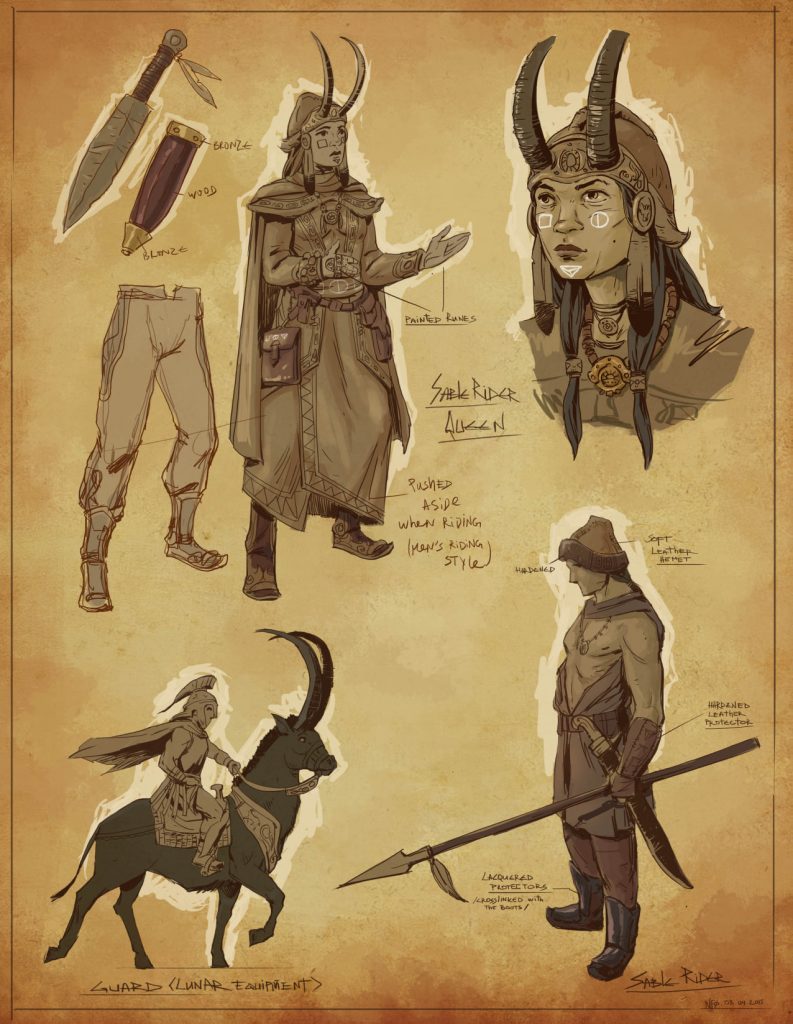
Reminder: you can quite reliably tell which NPCs were previously known from those that are new based on the length of their write-ups. Chaosium tends to keep expanding stuff from edition to edition, so those characters that had only a few lines in the 1980s are now one or two big paragraphs. Case in point:
Roneer the Hue, Tribal Khan
Born 1591, Roneer the Hue opposed the pro-Lunar Tribal Khan Inire the Red. He allied with the Paps priestesses to covertly resist Lunar influence after the First Battle of Moonbroth and he was given the ceremonial title of Paps Khan and married the Herd Mother Lareel. Seeking allies in the Wastes, he joined the White Bull Society and pledged loyalty to Argrath Whitebull. When Jaldon Goldentooth was summoned in 1624, Roneer killed with his own hand two Sable Khans who refused to pledge themselves to Argrath. At the Second Battle of Moonbroth, he personally killed Inire the Red and chased down his followers. Following the liberation of Pavis, Roneer seeks artefacts and spirits of power to aid his people in the coming wars in Dragon Pass.
Roneel declines the quasi-civilized finery of past Sable leaders, associating it with Lunar decadence. He wears trousers of coarse fabric, a plain tunic, and no cape. His once-jet hair has faded to a dull gray.
Inire the Red was the Sable Rider leader who made his tribe side with the Lunar Empire at the Battle of Moonbroth. He was obviously not popular with the other tribes after that, but I guess even inside the Sable Tribe not everybody was pro-Lunar. #NotAllSableRiders
Queen Lareel, Sable Queen
Born 1595, Lareel was a young Herd Priestess at the Paps when she saw greatness in the Sable Khan Roneer. Fiercely anti-Imperial, Lareel agreed to take Roneer as her husband but extracted an oath that he cannot enter her tent until the Sable Nation are no longer slaves of the Red Emperor. Despite this, she is initiated into the Red Mask Dancers and the Twin Stars. She dwells in the Prax and has quested deep into the secrets of the Earth Goddesses. She was proclaimed Sable Queen after the Second Battle of Moonbroth in 1624. Now she seeks to undermine Egajia Chewer of Flesh and be acclaimed High Priestess of the Paps.
Lareel has two secondary husbands, both khans, but both subordinate to Roneer. With her straight, broad shoulders, handsome features, and luxuriant eyebrows, Lareel cuts a striking and palpably intimidating figure.
I’ve got no idea what the Red Mask Dancers are, but I assume it’s some sort of minor Lunar cult, possibly related to Hon-eel. The Twin Stars are a couple of celestial deities who are synchronized to the cycle of the Red Moon phases. I get the feeling that Lareel is getting this deep understanding of Lunar mythology while being fiercely anti-Lunar Empire. This shows how the two aren’t irrevocably linked, which is important for someone of the Sable Tribe because the Sable Antelope has some deep connection with the moons of before Time.
Egajia Chewer of Flesh is the current High Priestess of the Paps, and is a Morokanth.
Queen Delenda, Rock Speaker Queen
The impressive, dignified Queen Delenda expertly maneuvered, as she so often does, when the pendulum of power swung from the Lunars to White Bull. Having switched sides with precision timing, she now entertains offers of alliance from Argrath’s favorite Sable, Roneer. Delenda has three husbands, the Rock Speakers Khan Boronwaha, the Wasp Stinger Kalanjho, and Rokzeel. All of Delenda’s relationships are about formal alliances and the good of the Rock Speakers than emotional attachment.
Ijiran, Red Sable Khan
The son of the slain Sable Khan Inire, Ijiran leads a band of Red Sables. One day he hopes to avenge his father’s death, killing Roneer in honorable combat and rejoining the tribe. He bides his time, waiting for the White Bull Army to burn out, and with it the political sway of Roneer and his wife Lareel. That leaves survival as the immediate goal. Ijiran cares more about redeeming his family honor than loyalty to the Lunars. Others of his band remain fervent Seven Mothers converts. They take special pleasure in disrupting Argrath’s supply chain.
Those last two NPCs are great for some faction play in a Praxian campaign!
Notable People of the Impala Tribe
And finally, the biggest tribe all, the Impala Tribe. We even get a few paragraphs of general description on the tribe:
The impalas ridden and herded by the Impala Tribe are larger than their wild brethren, but are still far smaller than any of the other riding animals of Prax. Their Riders, therefore, are small to match their steeds. Any child born to the Tribe who grows too large is banished.
Character concept alert! An Impala Rider who grew too big and is now riding something else! Actally, Jeff mentioned in passing that Greg himself had a Pol-Joni with this backstory.
Impalas graze in huge herds. Each of the males claim a patch of ground which they guard for use by their females and young. Bachelors are left to fend for themselves and tend to group together in skittish groups which surround the main herd and graze in unclaimed, poorer ground. The riders perform likewise, for they do not form a single huge camp like the bison riders. Instead the Impala people have many smaller camps surrounding their herds. Bachelors are not rejected by the tribe, but formed into warrior bands which earn their keep by herding and hunting and look forward to the day when they will be allowed to choose a wife.
Still the Impala Tribe are ready to band together for war. Their preferred weapon is the recurved bow, and they are master skirmishers. They have turn their small size and inability to carry armor (because of the comparatively small strength of their beasts) into an asset, for it forces them to concentrate on missile attacks. They are generally considered to be useless in a melee.
Despite their small size and lack of hand-to-hand prowess, the daring Impala Riders are some of the bravest individual warriors on the Plains. They devised the system of counting honors against a living foe by striking him and getting away unscathed. This practice is followed by young warriors of the other tribes, but the Impala people have practiced the methods until they are unparalleled.
This system of proving bravery has also gotten into their tribal politics, so that a great leader is one who can “touch” an opponent and humiliate them without taking a “wound” themself. This often makes clan squabbles entertaining for bystanders – and frustrating for slow-witten participants.
Their concentration on hunting prowess and missile weapons has made the Impala people one of the largest groups of worshipers of Yelmalio, which rivals the traditional Waha cult. Orlanth Adventurous is also popular among the warriors, and many bachelor societies are led by a Wind Lord instead of a khan.
Like Bison Riders, the Impala were leaders of the defence of Prax against the Lunar Empire. Though their sure-footed beasts did not fall victim to caltrops, their arrows did little against the Lunar heavy infantry, and when the Lunar cavalry charged, the Impalas could not hold their ground. They were forced to flee and scattered when their heavy support was doomed, and were exiled beyond Vulture’s Country. Neither tribe is happy with the other, since each feels betrayed by the other in the battle. Like the Bison Tribe, the Impalas returned to Prax in 1624, but unlike the Bison Riders the tribe is divided about the role of the White Bull.

The important people are:
Mokwaha Hearthand, Tribal Khan
Born 1585, more commonly known as “that fierce pygmy”, Mokwaha was blinded by a Sartarite war party many years ago, but has replaced his human eyes with one from a mouse and one from a bear. He hates all non-Praxians and will not suffer them to live in his presence. Mokwaha fled to Vultures Country in 1621, but returned leading numerous Impala Riders to attack settlements throughout the River of Cradles. Although Mokwaha acknowledges Jaldon Goldentooth’s primacy, he is not a member of the White Bull Society and pointedly follows Jaldon and not Argrath.
I suppose that with both mouse and bear sight, Mokwaha benefits from prey vision and predator vision. One of his eyes lets him detect movement easily without having to focus on anything in particular, while his other eye gives him precise vision with some night-time reflective elements. Or something. I don’t want to think about it too much…
Jaldon Goldentooth is a Bison Tribe hero from the Second Age, who conquered Pavis. Argrath summoned him to retake New Pavis from the Lunars — both of which helped a lot to federate many nomad clans behind him, in addition to his relationship to the White Bull.
Varata, Eiritha Prophet
Varata is a shaman and initiate of Eiritha. An early recruit to the White Bull Society, experienced a spirit visitation from Mother Impala, in which she was instructed to achieve unity between the five tribes, starting with the Bisons. A teeming group of Impala Riders follows her wherever she goes, proclaiming her a prophet of peace who will one day eclipse Argrath.
I don’t know where these followers heard their prophecies, but hey, it’s nice having a fan club. Plus, as far as Praxian tribes are concerned, the prophecy might be true: once Argrath is gone into Dragon Pass, Varata might indeed rise to prominence in local politics.
N’Krun, Impala Waha Khan
N’krun has wholeheartedly embraced the White Bull movement. All his life he has led his people with caution, always one bad moment from disaster. By crushing the oppressive Lunars, White Bull will usher in a new era of unity and freedom. Though N’krun still acts judiciously in his everyday life, he looks forward to the great new day promised by the Eiritha shaman Varata, who has shared with him a convincing tale of a revelation from Eiritha in the spirit realm. Argrath gave the New Pavis Temple of Eiritha and Waha to N’Krun and his wife Lalaira Horndaughter.
Lalira Horndaughter, Eiritha Herd Mother
The wife of N’Krun, Lalira has been given the New Pavis Temple to Eiritha and Waha by Argrath. Lalira’s new position forces an uncomfortable reconsideration of the attitudes she has always lived by. She used to believe that all Praxians should come together through the blessings of Eiritha, and that no other culture warrants trust or admiration. Now she finds herself in a dizzying era of cooperation between nomad and Sartarite, required to live in a settlement, under the command of a so-called Praxian who vies for an Orlanthi throne.
She loves her husband N’krun unreservedly but fears the trust he has placed in White Bull. Unusually tall for an Impala Rider, she has a long, willowy frame, high cheekbones, and a pointed chin.
She’s not wrong. Just sayin’.
Yellow-Face, Impala Light Captain
Yellow-Face (born 1594) is the martial leader of the Yelmalio cult for the Impala Nation. He maintains stiffly formal relationships with the Yelmalio cult leaders in Pavis and Sun County, holding them in private disdain. Famed for his skill at striking a foe and getting away unscathed, Yellow-Face carries a staff marked with a hawk feather for each success. Yellow-Face spends each Truth Week purifying himself, appearing publicly only to fight and lead his followers in war. He pointedly refuses to follow White Bull captains, demanding to be an equal to any other war leader present.
Yellow-Face wears a golden mask in battle that can shine like the sun.
I love a good Yelmalion.
Ilina Lightning Thief, Impala Wind Lord
Born 1600, Ilina’s parents, both Impala warriors, died at the First Battle of Moonbroth and she ended up an orphan in the Badside of New Pavis, becoming a leader of the Blood Knives. She was brought back into the Impala Nation by a fellow exile, and joined the Orlanth Adventurous cult. She was an early recruit into the White Bull Society and has pledged her loyalty to Argrath White Bull. She is the marital leader of the Orlanth Adventurous cult for the Impala Nation.
Ilina is open minded and adventurous, and more than a little reckless.
Jovanka the Tall, Impala Seven Mothers priestess
Born 1595, Jovanka was banished from her clan for being too tall to ride an Impala. She was embraced by the Seven Mothers cult of New Pavis, and received an oversized Impala from Sor-eel the Short. She returned to her tribe as a Lunar missionary – through her efforts she now leads one of the largest Praxian Seven Mothers temples outside of the Sable Nation. She kept her temple officially neutral when the White Bull attacked New Pavis, although she provided shelter for many Lunar refugees.
Nice. Jovanka adds some much needed nuance and complication to New Pavis in the post-Dragonrise era.
About the White Bull
Here are Jeff’s notes about the White Bull:
By 1625, about one in twenty Praxians follow the White Bull Society. This of course varies by tribe. The Bison and High Llama tribes have the most members, with nearly one in ten following the White Bull, followed by the Sable Tribe (although the Pol-Joni have the highest percentage of members).

The Impala and the Morokanth have the fewest members as a percentage of the population. Even then, there are nearly a thousand morokanth in the White Bull society and nearly twice that in the Impala.
In total, approximately 13,000 Praxians follow the White Bull. As they are an intertribal society and pledged personally to him, without the filter of clan, this gives Argrath immense military resources.
That being said, Argrath must tread carefully with the Great Khans as only the khans of the High Llamas, Bison, and Sables have pledged personal loyalty to the White Bull.
And with this you can begin to see the contours of White Bull-era Praxian politics. Argrath, who is NOT a khan, has a growing number of warriors and priests from the Waha, Storm Bull, and Orlanth cults who are personally loyal to him – in many cases, above tribe and other cult ties. The High Llama and Bison tribal leaders are strong supporters, as is the current Sable leaders. But the Impala and Morokanth’s support is shallower and more pragmatic. And there are plenty of ambitious leaders who simply wait for Argrath’s confederation collapses like so many before him.
At the same time, tribal affairs remain dominated by the Waha-Eiritha cults. Eiritha especially is outside of Argrath’s authority (he is a husband-protector of the Earth, and not its ruler), although many herd priestesses support him.
Jeff adds this comment on how loyalty to the White Bull (aka Argrath) cuts through traditional tribal lines:
Usually Praxian cults are organized on a tribal level, so we have Waha-Bison, Eiritha-Bison, Waha-High Llama, etc. But the White Bull cult is organized around Argrath without tribal filter.
Back to conquests:
I suspect it is to everyone’s pleasure that Argrath enters Dragon Pass with Jaldon and the core of the White Bull movement.
In 1625, this White Bull society led “confederation” of Praxian tribes is still quite new and quite unstable. Also worth keeping in mind that more than half of all Praxians are in the Wastelands.
The White Bull society likely circle around New Pavis, where the White Bull is. So between Pavis and Dragon Pass (Good Place, Caravan Alley, etc.), most Praxians encountered are likely connected with the White Bull (if they are not members, they have close kin who are). There are White Bull clusters in the grasslands near the Vast Teeth Hills.
But elsewhere the society’s presence can be quite thin. You can find bands in Wahaoranstol (the southern Wastes) or near the Snowline that are completely unaware of the White Bull. Or bands in the Head Acres with very few members.
Now this also helps explain the political crisis in Sartar post-Dragonrise. Kallyr is there on the scene and liberates Boldhome and leads the warriors there to fight off a last Lunar offensive at Dangerford. She’s acclaimed Prince on the grounds that:
1. She was nearly acclaimed Prince back in 1613 so people are used to her claims. After a dozen years, plenty of folk assume she IS Prince already!
2. She is the great-granddaughter of Prince Jarolar.
3. She leads the army that is there at Boldhome and after Dangerford, she’s pretty popular!Argrath on the other hand has a much bigger military at his beck and call. He’s the great-great-great grandson of Prince Saronil, which is a slender thread indeed. But his military forces are primarily Praxians that worship him as the White Bull. He’s not personally known except to his companions and followers – he’s not been a fixture in Sartarite politics at all, and has little contact with his clan and tribe.
When Kallyr dies, he’s the logical choice, but people fear what they don’t known – and Argrath is a big unknown. In the end, he marches on Boldhome in 1627 and is acclaimed Prince, but there’s a lot of uncertainty swirling around him.
Now it is unlikely that Argrath and Kallyr were the only possible heirs to Sartar. I suspect there were several Esrolians who might fit the bill. But they are the only candidates with a snow ball’s chance in Lodril’s furnace of success.
So if we think about the military resources that Argrath has easily available as Prince in addition to the Sartarite Free Army and City Militia, he’s got access to more than 10,000 Praxian cavalry. Which is nearly half as many cavalry as the entire Lunar Army had in 1621 – and more than the Lunar Army had in its campaigns in Dragon Pass and the Holy Country.
This also goes a long way towards explaining why Argrath – unlike Kallyr – made cavalry his decisive arm. Like Alexander, Argrath was fundamentally a brilliant cavalry leader, although even the Lunars eventually agreed that he always made excellent uses of the forces he had at hand, even second rate infantry.
Why is the White Bull Society so popular:
Beyond providing useful magic, the White Bull cult provides a way that Praxians can cooperate with each other against their foes beyond the limits of tribal structure. The cult is associated with and shared by the cults of Waha, Storm Bull, and Orlanth. During the Lunar Occupation, the White Bull became the most effect means of resistance and counter-attack.
The White Bull cult has very few Yelmalion members. I think the Sun County hierarchy is understandably more concerned that the Praxians are far more numerous now and that they have formed a confederation, making it much more difficult to play tribes off against each other.
As an aside, the White Bull cult is associated with and shared by Orlanth, Storm Bull, and Waha, and it often forms a subcult of those cults that is held in common by all three (providing a point of cooperation among those cults).
The flip side of that is that it does not provide a whole lot of Yelmalio – except that the Sun Dome must be even more careful than usual.
Community Roundup
The community roundup is our highlight of interesting things being mentioned in the Glorantha-related Facebook groups, sub-Reddits, and other similar online places.
RPGImaginings Continues the SoloQuest
I didn’t post a link to all of these SoloQuest videos, but better late than never! Vasana gets into a dangerous duel with a Lunar, and we learn how the Battle of Dangerford ends. The four-part series is available here.
RuneQuest Through White Dwarf
Over on Twitter, @OldShabbyGamer reminisces about the RuneQuest adventures from the magazine White Dwarf:
1/The first RuneQuest adventures I ran were “The Money Tree” from RQ3’s advanced rulebook and “When Mad Gods Laugh” from White Dwarf #88 (1987). The first was fairly generic and forgettable (even 35 years ago!), but the latter had something primeval and sinister about it.
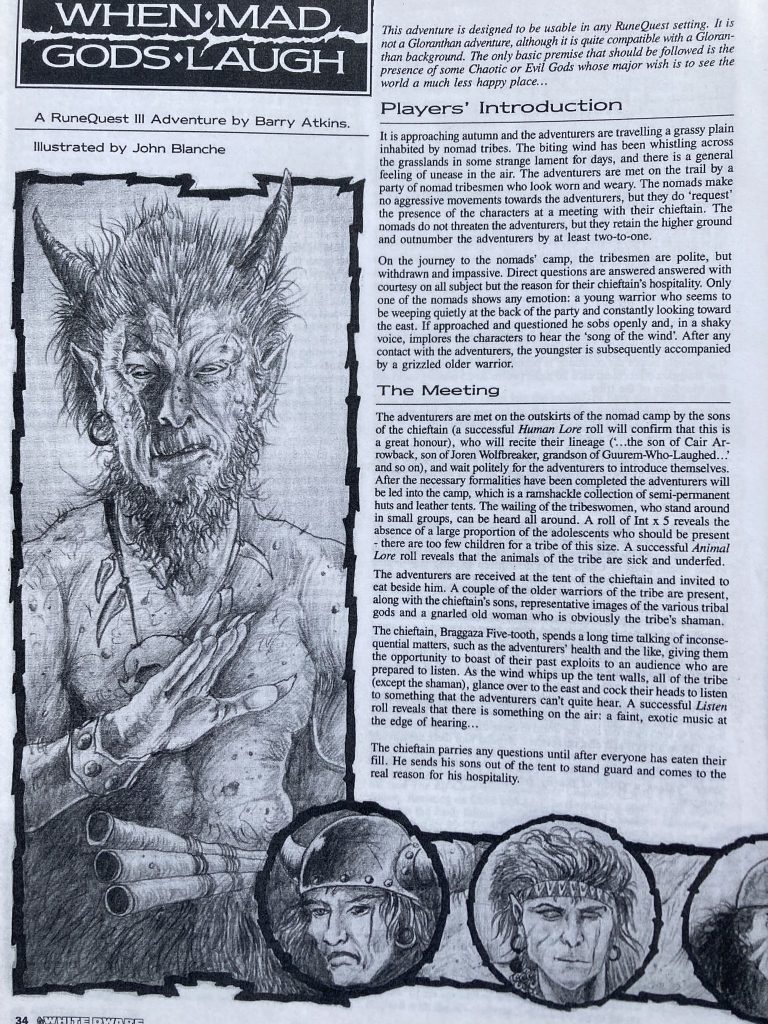
2/And always that tantalizing mention of “Glorantha” in White Dwarf, but no traces remaining in the rules (like socialism in the Labour party). A Tale to Tell (WD#85) fascinated me, but I don’t think I ran it because the Gloranthan lore (at once so attractive) felt so dense.
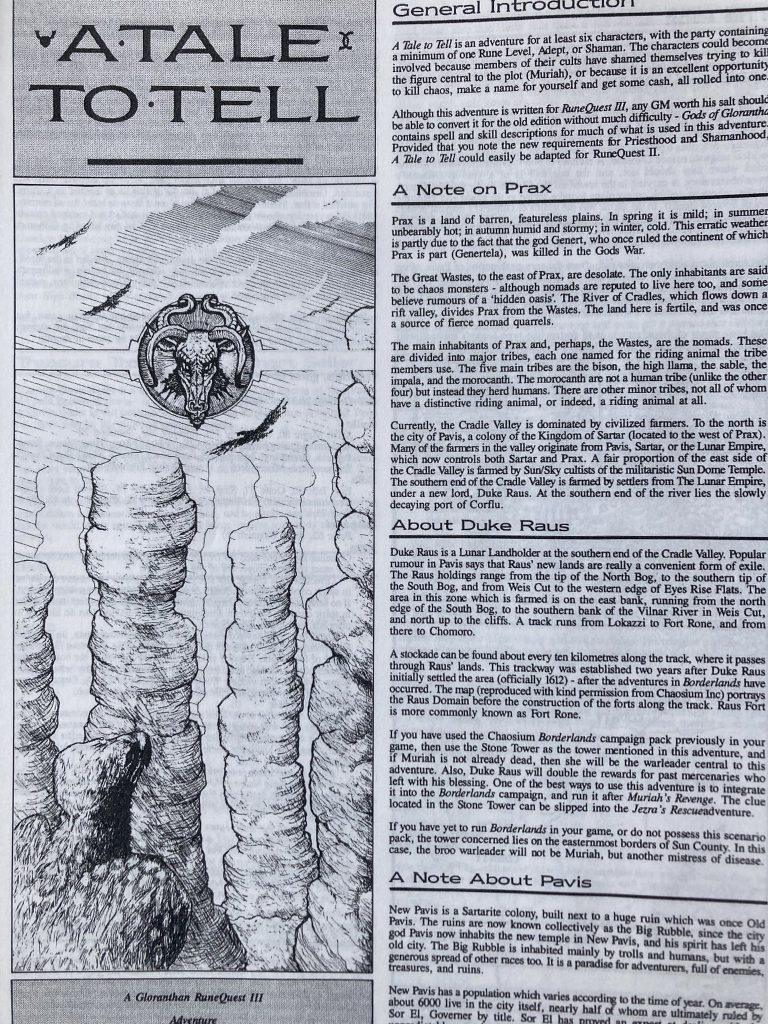
3/White Dwarf’s early years were closely intertwined with RuneQuest, and I hope to rediscover some lost gems as I start running RQG sometime this year. Still it’s sobering to discover that I’m a RQ newbie but ran my first games for it in 1987!
Did anybody run these scenarios? I’d love to hear some feedback about them. I might hunt down some old White Dwarf issues…
Stuck in rabbit hole, please send Pleistocene era carrots
I’m not going to say anything, just go check it out. This is why I love Erin and Beer With Teeth.
Six Ages on Sale
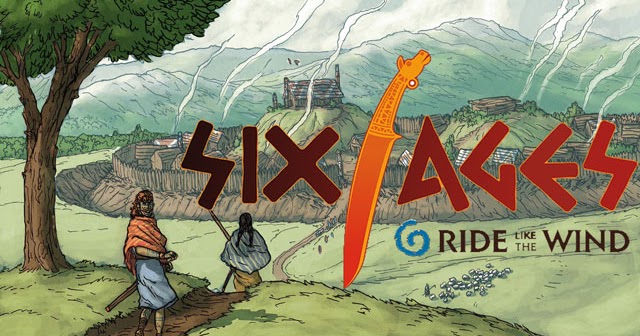
The Gloranthan video-game Six Ages is currently on sale on Steam (even though I prefer the iPad version personally).
Elsewhere on Arachne Solara’s Web
Not everything is about Glorantha, although most things are! Here are loosely relevant things that we found on the interwebs.
Lascaux’s Aurochs and Black Stag
The caves of Lascaux are a famous archaeological site in Southwestern France that features hundreds of… err, “parietal art“. I guess that’s my new word of the day. It sounds fancier than “doodles on rock”.

This painting is in the “Hall of Bulls”, which is a section of the caves featuring a lot of animals like bovines and equines and such. Most importantly, it features aurochs, which also show up in Argrath’s story in Glorantha (he supposedly “brought them back” to Dragon Pass). So here you have a ready-to-use handout when your players find some old auroch-related prophecy in a cave!

I like this one: it’s called “the Black Stag” and it’s thought to be a painting of a Megaloceros, an ancestor species of the deer that was 2 meters tall at the withers. That’s one big fucking deer! Your players probably need to, like, bring him back from the God Time and worship him and such, right? Right?
Virtual Visit of Skara Brae
Skara Brae is a Hsunschen… errr, I mean, Neolithic settlement found in Northern Scotland. It’s pretty much 5000 years old, and you can now visit it from the comfort of your sofa! There’s also a detailed model of one of the dwellings. Check it out on SketchFab.
Fingal’s Cave
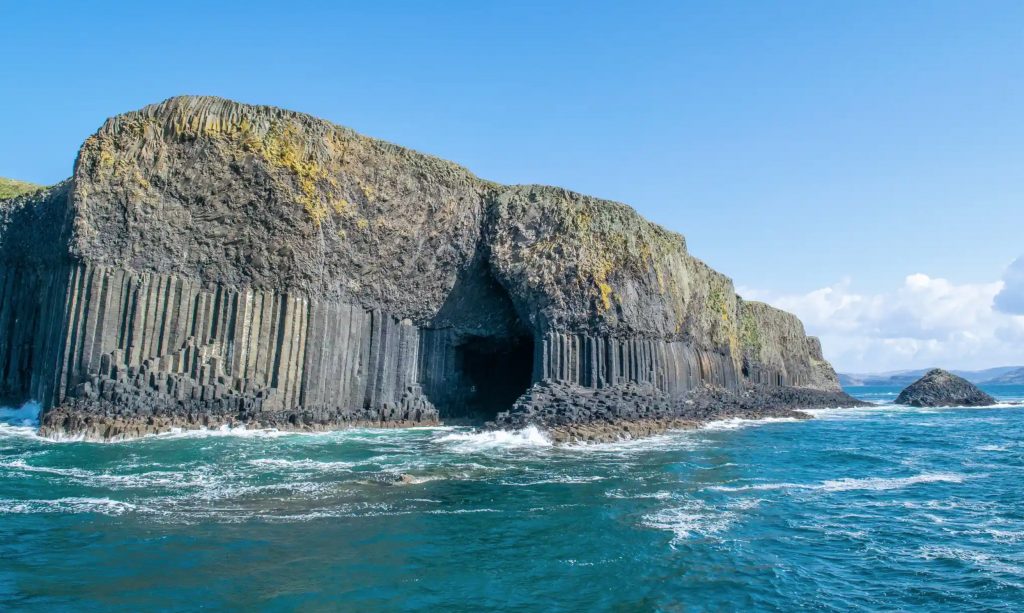
This cave in Staffa, Scotland, is one of the most famous examples of hexagonal basalt columns, and a great inspiration for a cool location in your games. You can find many photos and videos of this cave, but here’s one if you’re curious right now:
For more columnar basalt goodness, also check out the Giant’s Causeway, in Ireland (among many other places in the world featuring this phenomenon):
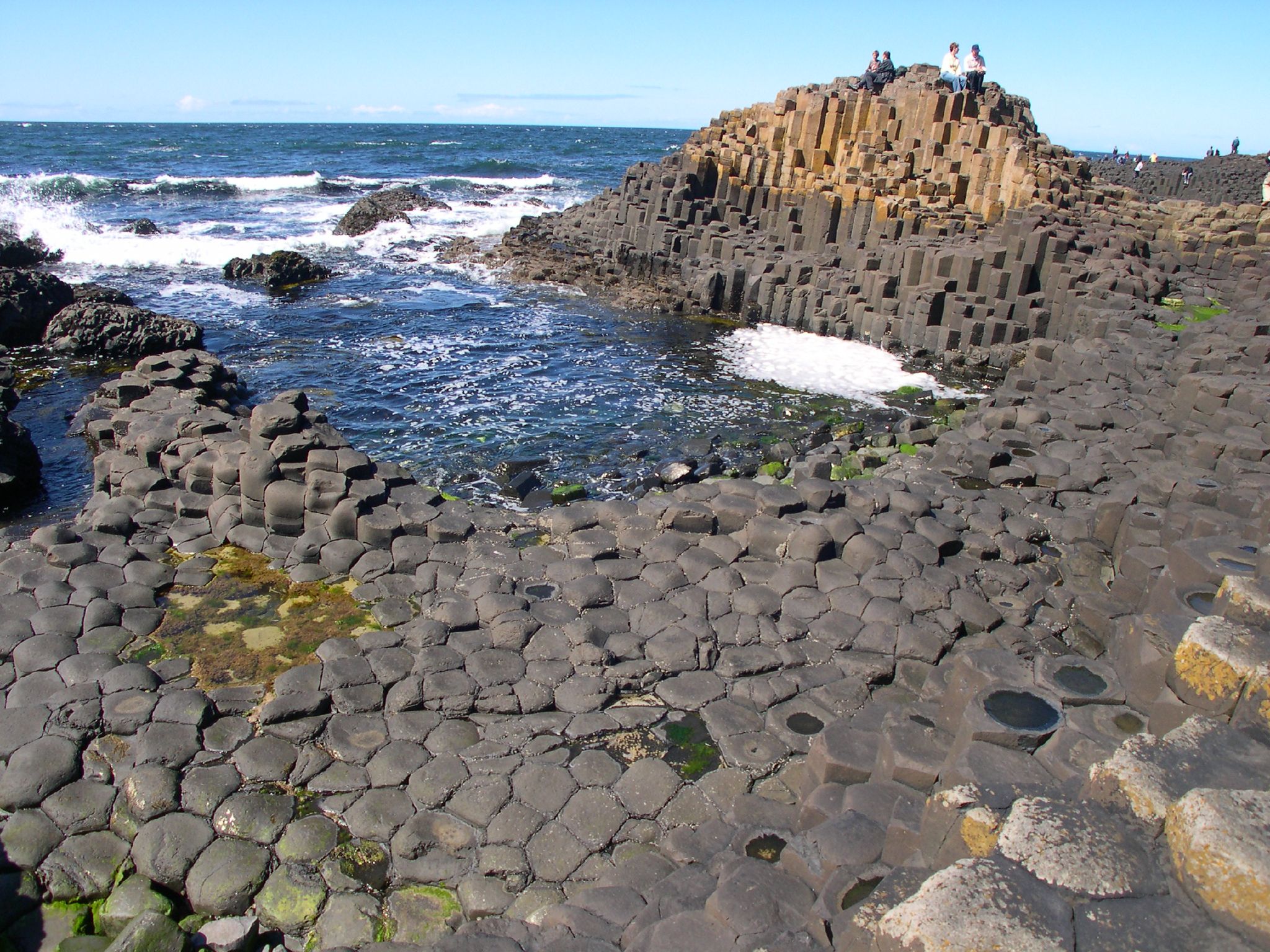
Technically all you need to justify columnar basalt in your game is the past existence of a volcano, and the rapid cooling of lava flow, which is why these sites are almost always by the water. But Glorantha isn’t tied to physics, so maybe it wasn’t a volcano, and instead it was Lodril. And maybe it wasn’t water cooling, it was Valind or some strong Air spirits blowing over it. You can even just shrug and say that some Earth goddess made it this way, but that might be unsatisfying — I find that myths are best when there’s an intersection between a silly narrative and an explanation of the real-world. At the very least I would give a reason, such as Ernalda building a hexmap table for Orlanth’s gaming club…
Thank you for reading
That’s it for this week! Please contact us with any feedback, question, or news item we’ve missed!





